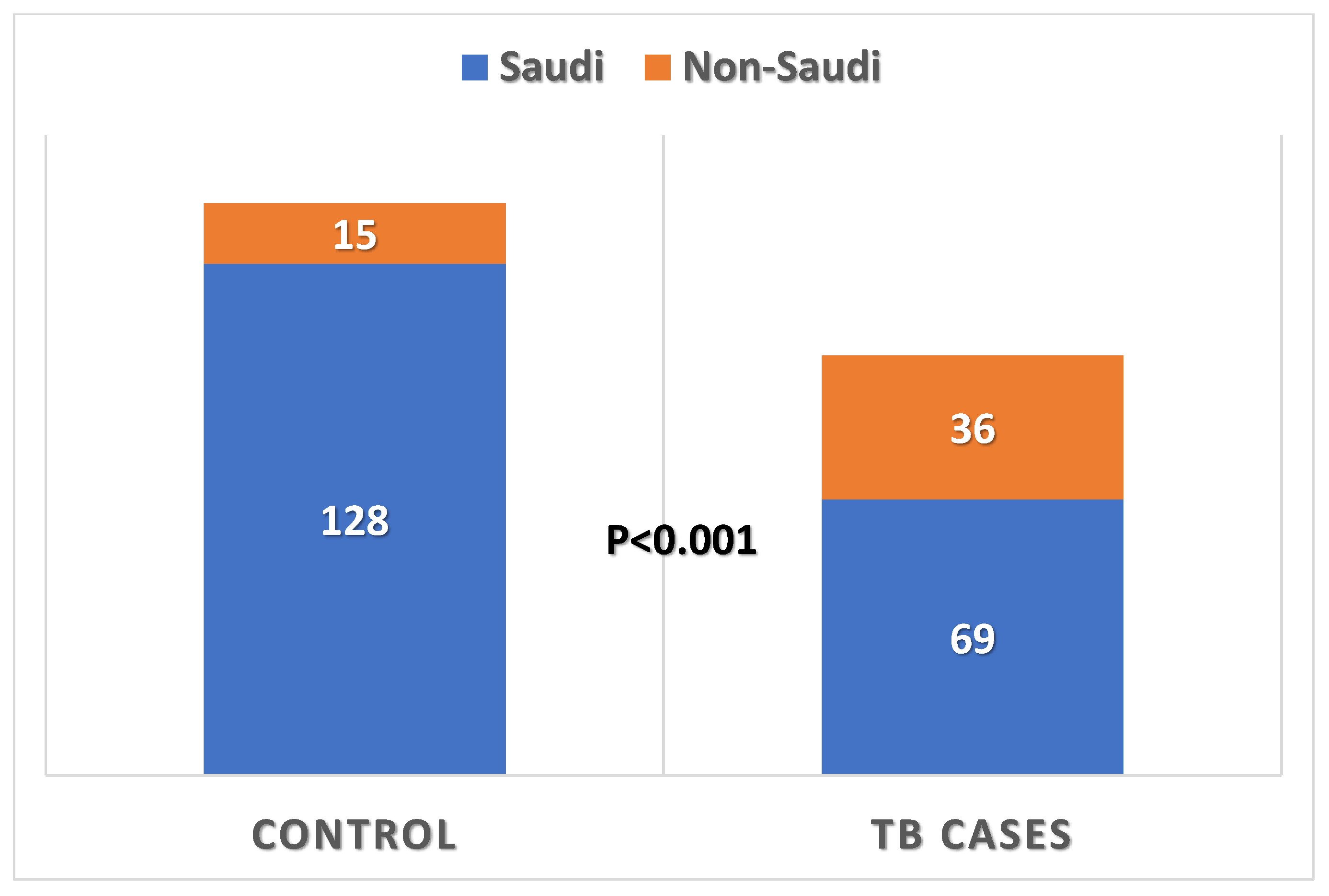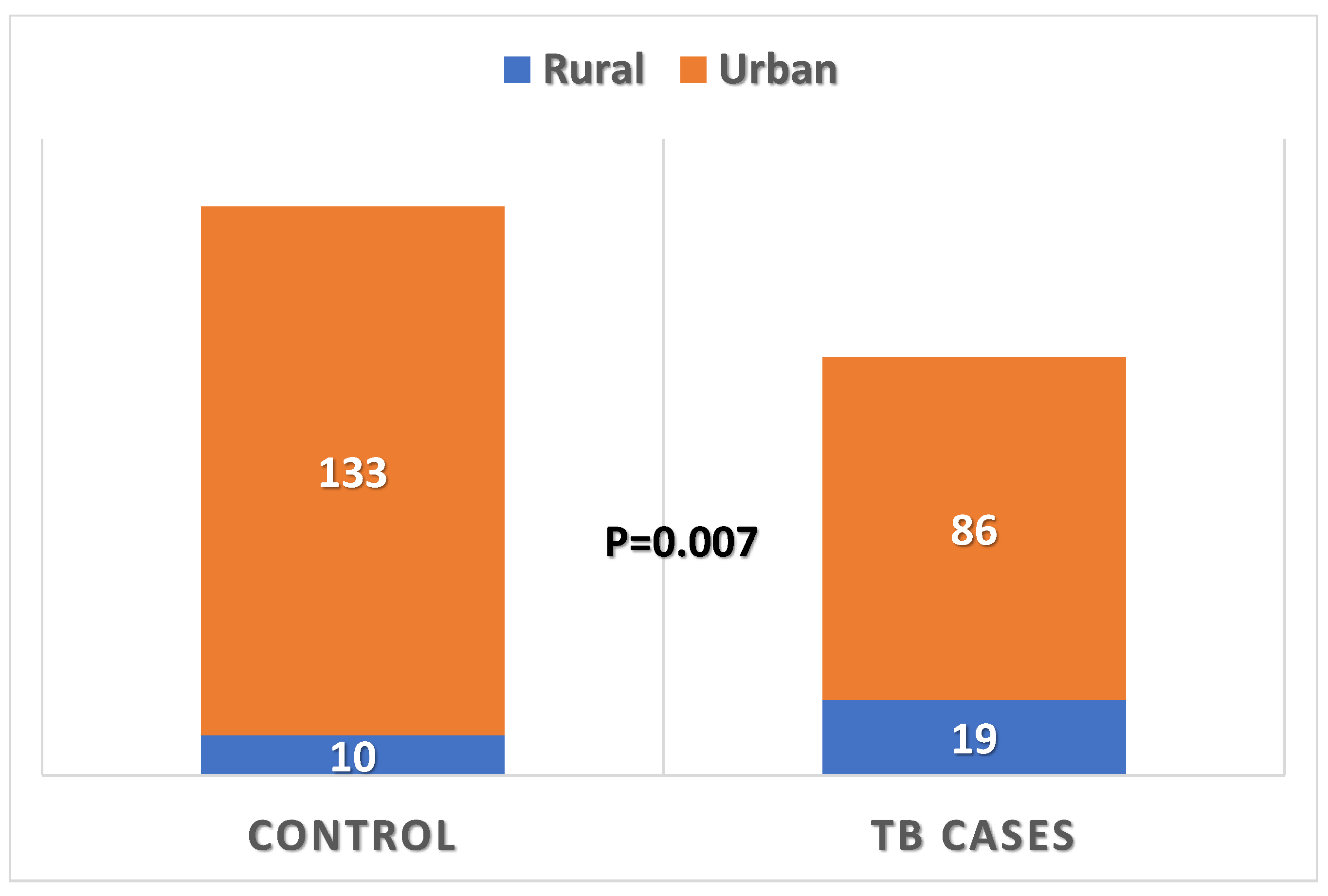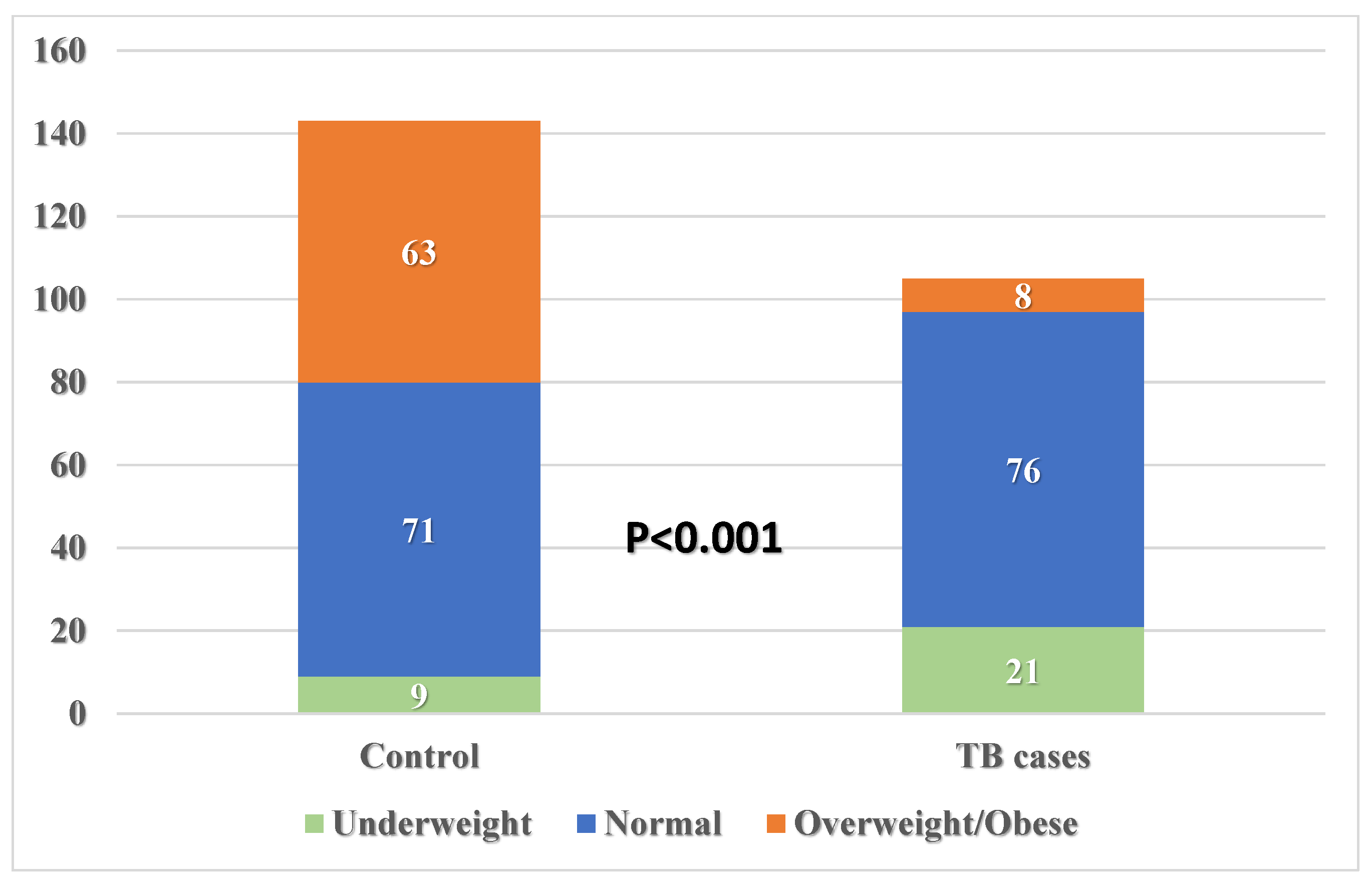Risk Factors of Pulmonary Tuberculosis in Aseer Region, Saudi Arabia: A Case–Control Study
Abstract
1. Introduction
2. Materials and Methods
2.1. Study Population
2.2. Sample Size
- Acceptable margin of error: 5%;
- Confidence level: 95%;
- Population size: 130;
- Response distribution: 50%.
2.3. Selection of Cases
2.4. Selection of Control Subjects
2.5. Data Collection Tool
2.6. Ethical Considerations
2.7. Time Frame
2.8. Data Analysis
3. Results
4. Discussion
5. Conclusions
Author Contributions
Funding
Institutional Review Board Statement
Informed Consent Statement
Data Availability Statement
Acknowledgments
Conflicts of Interest
References
- Barberis, I.; Bragazzi, N.L.; Galluzzo, L.; Martini, M. The history of tuberculosis: From the first historical records to the isolation of Koch’s bacillus. J. Prev. Med. Hyg 2017, 58, E9–E12. [Google Scholar] [PubMed]
- Duko, B.; Bedaso, A.; Ayano, G.; Yohannis, Z. Perceived Stigma and Associated Factors among Patient with Tuberculosis, Wolaita Sodo, Ethiopia: Cross-Sectional Study. Tuberc. Res. Treat. 2019, 2019, 5917537. [Google Scholar] [CrossRef]
- Saati, A.A.; Khurram, M.; Faidah, H.; Haseeb, A.; Iriti, M. A Saudi Arabian Public Health Perspective of Tuberculosis. Int. J. Environ. Res. Public Health 2021, 18, 10042. [Google Scholar] [CrossRef] [PubMed]
- Jurado, L.F.; Pinzón, B.; De La Rosa-Noriega, Z.R.; Matijasevic, E.; del Pilar López-Panqueva, R. Peritoneal tuberculosis in a health-care worker, radio-pathological assessment and diagnosis, a case report. Radiol. Infect. Dis. 2019, 6, 163–169. [Google Scholar] [CrossRef]
- Ashaba, C.; Musoke, D.; Wafula, S.T.; Konde-Lule, J. Stigma among tuberculosis patients and associated factors in urban slum populations in Uganda. Afr. Health Sci. 2021, 21, 1640–1650. [Google Scholar] [CrossRef] [PubMed]
- PAHO. World Tuberculosis Day 2022. Invest to End TB. Save Lives. The Pan American Health Organization (PAHO). Available online: https://www.paho.org/en/campaigns/world-tuberculosis-day-2022 (accessed on 24 October 2025).
- Ahmed, M.M.; Velayati, A.A.; Mohammed, S.H. Epidemiology of multidrug-resistant, extensively drug resistant, and totally drug resistant tuberculosis in Middle East countries. Int. J. Mycobacteriol. 2016, 5, 249–256. [Google Scholar] [CrossRef]
- WHO. Tuberculosis Prevalence Surveys: A Handbook; World Health Organization: Geneva, Switzerland, 2011; Available online: https://www.who.int/publications/i/item/9789241548168 (accessed on 12 June 2024).
- Udoakang, A.J.; Djomkam Zune, A.L.; Tapela, K.; Nganyewo, N.N.; Olisaka, F.N.; Anyigba, C.A.; Tawiah-Eshun, S.; Owusu, I.A.; Paemka, L.; Awandare, G.A.; et al. The COVID-19, tuberculosis and HIV/AIDS: Ménage à Trois. Front. Immunol. 2023, 14, 1104828. [Google Scholar] [CrossRef]
- Jackson, S.; Kabir, Z.; Comiskey, C. Effects of migration on tuberculosis epidemiological indicators in low and medium tuberculosis incidence countries: A systematic review. J. Clin. Tuberc. Other Mycobact. Dis. 2021, 23, 100225. [Google Scholar] [CrossRef]
- Abdelwahab, S.I.; Taha, M.M.E.; Albasheer, O.; Alharbi, A.; Ahmed, A.A.; Abdelmola, A.; Ali, S.A.; El Hassan, L.A.; Darraj, M.; Mohamed, A.H.; et al. Tuberculosis research advances and future trends: A bibliometric knowledge mapping approach. Medicine 2024, 103, e39052. [Google Scholar] [CrossRef]
- Alawi, M.M.; Alserehi, H.A.; Ali, A.O.; Albalawi, A.M.; Alanizi, M.K.; Nabet, F.M.; Alkamaly, M.A.; Assiri, A.M.; Jokhdar, H.; Qutub, M.O.; et al. Epidemiology of tuberculosis in Saudi Arabia following the implementation of end tuberculosis strategy: Analysis of the surveillance data 2015–2019. Saudi Med. J. 2024, 45, 60–68. [Google Scholar] [CrossRef]
- Xi, Y.; Zhang, W.; Qiao, R.-J.; Tang, J. Risk factors for multidrug-resistant tuberculosis: A worldwide systematic review and meta-analysis. PLoS ONE 2022, 17, e0270003. [Google Scholar] [CrossRef]
- Chen, H.; Tong, Z.; Zhong, J.; Zeng, Q.; Shen, B.; Qian, F.; Xiao, X. Epidemiological characteristics and risk factors analysis of multidrug-resistant tuberculosis among tuberculosis population in Huzhou City, Eastern China. Open Life Sci. 2025, 20, 20251081. [Google Scholar] [CrossRef]
- Pasipanodya, J.G.; Srivastava, S.; Gumbo, T. Meta-analysis of clinical studies supports the pharmacokinetic variability hypothesis for acquired drug resistance and failure of antituberculosis therapy. Clin. Infect. Dis. 2012, 55, 169–177. [Google Scholar] [CrossRef]
- Tiberi, S.; du Plessis, N.; Walzl, G.; Vjecha, M.J.; Rao, M.; Ntoumi, F.; Mfinanga, S.; Kapata, N.; Mwaba, P.; McHugh, T.D.; et al. Tuberculosis: Progress and advances in development of new drugs, treatment regimens, and host-directed therapies. Lancet Infect. Dis. 2018, 18, e183–e198. [Google Scholar] [CrossRef]
- Pal, A.; Acharya, T.; Hamal, K.; Acharya, N.; Shah, K.B. Prevalence of Tuberculosis Among High Altitude Residents of Nepal. Nepal Med. Jor. 2023, 6, 25–29. [Google Scholar] [CrossRef]
- Pérez-Padilla, R.; Franco-Marina, F. The impact of altitude on mortality from tuberculosis and pneumonia. Int. J. Tuberc. Lung Dis. 2004, 8, 1315–1320. [Google Scholar]
- Narasimhan, P.; Wood, J.; MacIntyre, C.R.; Mathai, D. Risk factors for tuberculosis. Pulm. Med. 2013, 2013, 828939. [Google Scholar] [CrossRef] [PubMed]
- Alrajhi, A.A.; Al-Barrak, A.M. Epidemiology of Tuberculosis in Saudi Arabia; Madkour, T.M.M., Ed.; Springer: Berlin/Heidelberg, Germany, 2004. [Google Scholar]
- Almutairi, F.M.; Tayeb, T.; Alhakeem, R.; bin Saeed, A.; Assiri, A.; McNabb, S.J. Distribution and determinants of tuberculosis in the Kingdom of Saudi Arabia from 2005 to 2012. J. Epidemiol. Glob. Health 2018, 7, S23–S28. [Google Scholar] [CrossRef] [PubMed]
- Alshahrani, F.; Zafar, M.; Omer, E.O. Lifestyle risk factors associated with tuberculosis patients in Asir region of Saudi Arabia. Int. J. Prev. Med. 2021, 12, 89. [Google Scholar] [CrossRef] [PubMed]
- Kapilawanse, S.; Bichha, R.P.; Samaraweera, S.; Pallewatte, N.; Vitharana, H.; Jayakody, W.; Gangathesewaran, M. Tuberculosis Among Young People on Rise in Sri-Lanka (An Analysis of Trend and Associated Factors). SAARC J. Tuberc. Lung Dis. HIV/AIDS 2018, 14, 18–30. [Google Scholar] [CrossRef]
- Tesema, C.; Tadesse, T.; Gebrehiwot, M.; Tsegaw, A.; Weldegebreal, F. Environmental and host-related determinants of tuberculosis in Metema district, north-West Ethiopia. Drug Health Patient Saf. 2015, 7, 87–95. [Google Scholar] [CrossRef] [PubMed]
- Duarte, R.; Lönnroth, K.; Carvalho, C.; Lima, F.; Carvalho, A.; Muñoz-Torrico, M.; Centis, R. Tuberculosis, social determinants and co-morbidities (including HIV). Pulmonology 2018, 24, 115–119. [Google Scholar] [CrossRef] [PubMed]
- Akashanand; Samal, S.K.; Gaidhane, S.; Jena, D.; Roopashree, R.; Kaur, M.; Nathiya, D.; Sharma, A.; Prasad, G.S.; Sinha, A.; et al. Epidemiological trends and forecasting of tuberculosis burden in the Gulf Cooperation Council countries: Evidence from global burden of disease 1990–2021. J. Infect. Public Health 2025, 18, 102736. [Google Scholar] [CrossRef] [PubMed]
- Alqadasi, E.T.; Chamroonsawasdi, K.; Saejeng, K.; Nagi, M.A. Burden of non-communicable diseases in Health Council of Gulf Cooperation (GCC) countries. J. Taibah Univ. Med. Sci. 2024, 19, 877–884. [Google Scholar] [CrossRef]
- Sulidah, S.; Irwan, M.; Elmania, E.; Fadlilah, S.; Hamdani-Rahil, N.; Nugroho, A. Home environment as a risk factor for increased incidence of tuberculosis: A case-control study. Cienc. Enferm. 2024, 30, 5. [Google Scholar]
- World Health Organization. Implementing the End TB Strategy: The Essentials, 2022 Update; World Health Organization: Geneva, Switzerland, 2022. [Google Scholar]
- World Health Organization. Global Tuberculosis Report 2023; World Health Organization: Geneva, Switzerland, 2023. [Google Scholar]



| Characteristics | Frequency | Percent |
|---|---|---|
| Year of diagnosis | ||
| 95 | 90.5 |
| 10 | 9.5 |
| Type of TB patient | ||
| 100 | 95.2 |
| 5 | 4.8 |
| Place of residence | ||
| 42 | 40.0 |
| 45 | 42.9 |
| 18 | 17.1 |
| Control (n = 143) | TB Cases (n = 105) | p | ||||
|---|---|---|---|---|---|---|
| Characteristics | No. | % | No. | % | Value | |
| Age groups | <20 | 9 | 6.3 | 6 | 5.7 | |
| (in years) | 20–29 | 48 | 33.6 | 45 | 42.9 | |
| 30–39 | 44 | 30.8 | 28 | 26.7 | 0.658 | |
| 40–49 | 28 | 19.6 | 16 | 15.2 | ||
| 50+ | 14 | 9.8 | 10 | 9.5 | ||
| Sex | Male | 100 | 69.9 | 83 | 79.0 | |
| Female | 43 | 30.1 | 22 | 21.0 | 0.107 | |
| Nationality | Saudi | 128 | 89.5 | 69 | 65.7 | |
| Non-Saudi | 15 | 10.5 | 36 | 34.3 | <0.001 † | |
| Residence | Rural | 10 | 7.0 | 19 | 18.1 | |
| Urban | 133 | 93.0 | 86 | 81.9 | 0.007 † | |
| Marital status | Single | 63 | 44.1 | 74 | 70.5 | |
| Married | 80 | 55.9 | 31 | 29.5 | <0.001 † | |
| Family size | <3 | 25 | 17.5 | 10 | 9.5 | |
| 3–4 | 22 | 15.4 | 28 | 26.7 | ||
| 5–6 | 65 | 45.5 | 44 | 41.9 | 0.082 | |
| 7+ | 31 | 21.7 | 23 | 21.9 | ||
| Family History | Yes | 8 | 5.6 | 15 | 14.3 | |
| of TB | No | 135 | 94.4 | 90 | 85.7 | 0.020 † |
| Educational | Illiterate | 5 | 3.5 | 6 | 5.8 | |
| Status | Primary | 1 | 0.7 | 6 | 5.7 | |
| Intermediate | 9 | 6.3 | 9 | 8.6 | <0.001 † | |
| Secondary | 51 | 35.7 | 55 | 52.4 | ||
| University | 77 | 53.8 | 29 | 27.6 | ||
| Employment | Unemployed | 19 | 13.3 | 34 | 32.4 | |
| Status | Student | 28 | 19.6 | 9 | 8.6 | |
| Governmental job | 67 | 46.9 | 14 | 13.3 | <0.001 † | |
| Private job | 24 | 16.8 | 45 | 42.9 | ||
| Retired | 5 | 3.5 | 3 | 2.9 | ||
| Monthly | SAR < 5000 | 63 | 44.1 | 84 | 80.0 | |
| Income | SAR 5000–10,000 | 36 | 25.2 | 12 | 11.4 | <0.001 † |
| SAR > 10,000 | 44 | 30.8 | 9 | 8.6 | ||
| Smoking Status | Smoker | 27 | 18.9 | 22 | 21.0 | |
| Non-Smoker | 96 | 67.1 | 72 | 68.6 | 0.688 | |
| Ex-Smoker | 20 | 14.0 | 11 | 10.5 | ||
| Body Mass | Underweight | 9 | 6.3 | 21 | 20.0 | |
| Index (BMI) | Normal weight | 71 | 49.7 | 76 | 72.4 | <0.001 † |
| Grades | Overweight/obese | 63 | 44.1 | 8 | 7.6 | |
| Control (n = 143) | TB Cases (n = 105) | p | ||||
|---|---|---|---|---|---|---|
| Residential and Housing Conditions | No. | % | No. | % | Value | |
| Residence | Rural | 10 | 7.0 | 19 | 18.1 | |
| Urban | 133 | 93.0 | 86 | 81.9 | 0.007 † | |
| Housing type | Apartment | 98 | 68.5 | 89 | 84.8 | |
| Building | 21 | 14.7 | 13 | 12.4 | 0.001 † | |
| Villa | 24 | 16.8 | 3 | 2.9 | ||
| Housing | Lease | 70 | 49.0 | 34 | 32.4 | |
| condition | Rented | 73 | 51.0 | 71 | 67.6 | 0.009 † |
| Floor of | Ground | 46 | 32.2 | 49 | 46.7 | |
| residence | First | 46 | 32.2 | 28 | 26,7 | |
| Second or higher | 48 | 34.3 | 29 | 19.0 | 0.002 † | |
| Basement | 2 | 1.4 | 8 | 7.6 | ||
| No. of | 1 | 15 | 10.5 | 15 | 14.3 | |
| bedrooms | 2 | 33 | 23.1 | 25 | 23.8 | 0.629 |
| 3+ | 95 | 66.4 | 65 | 61.9 | ||
| No. of | 0 | 0 | 0.0 | 2 | 1.9 | |
| windows | 1 | 88 | 61.5 | 71 | 67.6 | 0.124 |
| 2 | 55 | 38.5 | 32 | 30.5 | ||
| No. of persons | One | 44 | 30.8 | 42 | 40.0 | |
| using a bedroom | More than one | 99 | 69.2 | 63 | 60.0 | 0.131 |
| Control (n = 143) | TB Cases (n = 105) | p | |||
|---|---|---|---|---|---|
| Comorbidities | No. | % | No. | % | Value |
| Diabetes | 15 | 10.5 | 10 | 9.5 | 0.803 |
| Hypertension | 13 | 9.1 | 4 | 3.8 | 0.104 |
| Respiratory disease | 4 | 2.8 | 1 | 1.0 | 0.295 |
| Arthritis | 3 | 2.1 | 1 | 1.0 | 0.434 |
| Chronic renal disease | 1 | 0.7 | 1 | 1.0 | 0.669 |
| Coronary heart disease | 1 | 0.7 | 0 | 0.0 | 0.391 |
| HIV/AIDS | 0 | 0.0 | 1 | 1.0 | 0.423 |
| Independent | Exp | p | 95% CI for Exp (B) | ||||
|---|---|---|---|---|---|---|---|
| Variables | B | S.E. | Wald | (B) | Value | Lower | Upper |
| Nationality | 0.884 | 0.442 | 4.005 | 2.421 | 0.045 † | 1.018 | 5.754 |
| Education | −0.124 | 0.179 | 0.478 | 0.884 | 0.489 | 0.623 | 1.255 |
| Marital | −0.307 | 0.373 | 0.677 | 0.736 | 0.411 | 0.354 | 1.529 |
| Income | −0.483 | 0.277 | 3.026 | 0.617 | 0.082 | 0.358 | 1.063 |
| Smoking status | −0.376 | 0.282 | 1.774 | 0.687 | 0.183 | 0.395 | 1.194 |
| Residence | −1.186 | 0.553 | 4.598 | 0.305 | 0.032 † | 0.103 | 0.903 |
| Floor | 0.033 | 0.095 | 0.118 | 1.033 | 0.731 | 0.858 | 1.244 |
| Family size | 0.030 | 0.189 | 0.026 | 1.031 | 0.872 | 0.712 | 1.494 |
| Bedrooms | 0.079 | 0.268 | 0.086 | 1.082 | 0.769 | 0.640 | 1.829 |
| Body mass index | −1.203 | 0.306 | 15.450 | 0.300 | <0.001 † | 0.165 | 0.547 |
| Job | 0.140 | 0.096 | 2.131 | 1.150 | 0.144 | 0.953 | 1.387 |
| Constant | 3.996 | 1.687 | 5.612 | 54.355 | 0.018 | ||
Disclaimer/Publisher’s Note: The statements, opinions and data contained in all publications are solely those of the individual author(s) and contributor(s) and not of MDPI and/or the editor(s). MDPI and/or the editor(s) disclaim responsibility for any injury to people or property resulting from any ideas, methods, instructions or products referred to in the content. |
© 2025 by the authors. Licensee MDPI, Basel, Switzerland. This article is an open access article distributed under the terms and conditions of the Creative Commons Attribution (CC BY) license (https://creativecommons.org/licenses/by/4.0/).
Share and Cite
Alsulayyim, F.S.; Alsabaani, A.A.; Garnan, M.A.; Alshash, A.B.; Elnoor Ali, A.A.; Aldail, M.A.; Asiri, M.A.; Nasser, F.A.; Mahmood, S.E. Risk Factors of Pulmonary Tuberculosis in Aseer Region, Saudi Arabia: A Case–Control Study. Healthcare 2025, 13, 2755. https://doi.org/10.3390/healthcare13212755
Alsulayyim FS, Alsabaani AA, Garnan MA, Alshash AB, Elnoor Ali AA, Aldail MA, Asiri MA, Nasser FA, Mahmood SE. Risk Factors of Pulmonary Tuberculosis in Aseer Region, Saudi Arabia: A Case–Control Study. Healthcare. 2025; 13(21):2755. https://doi.org/10.3390/healthcare13212755
Chicago/Turabian StyleAlsulayyim, Faris Saeed, Abdullah Abdulmohsen Alsabaani, Mohammad Abdullah Garnan, Amna Babiker Alshash, Asim Abdelwahid Elnoor Ali, Mohammed Awthah Aldail, Mazen Ali Asiri, Faten Ali Nasser, and Syed Esam Mahmood. 2025. "Risk Factors of Pulmonary Tuberculosis in Aseer Region, Saudi Arabia: A Case–Control Study" Healthcare 13, no. 21: 2755. https://doi.org/10.3390/healthcare13212755
APA StyleAlsulayyim, F. S., Alsabaani, A. A., Garnan, M. A., Alshash, A. B., Elnoor Ali, A. A., Aldail, M. A., Asiri, M. A., Nasser, F. A., & Mahmood, S. E. (2025). Risk Factors of Pulmonary Tuberculosis in Aseer Region, Saudi Arabia: A Case–Control Study. Healthcare, 13(21), 2755. https://doi.org/10.3390/healthcare13212755









